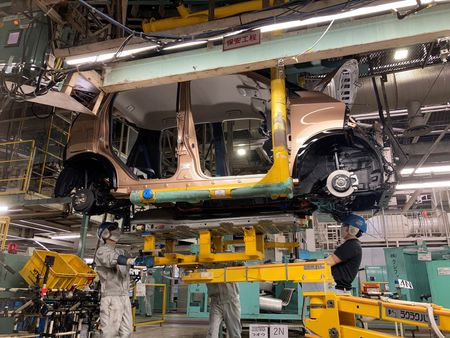By Tetsushi Kajimoto and Leika Kihara
TOKYO (Reuters) – Japan’s big companies are expected to deliver the largest pay rise in 26 years in next week’s “shunto” wage negotiations, offering policymakers hope the country might finally emerge from its deflationary doldrums.
But the expected average salary hike of around 3% will likely include just a 1% increase in base pay, casting doubt on whether Japan can achieve the kind of sustained wage gains the central bank sees as key to stably hitting its 2% inflation target.
The outcome of “shunto” wage talks with unions, many of which conclude on March 15, will be crucial to how soon the Bank of Japan (BOJ) could end its bond yield control policy under incoming governor Kazuo Ueda.
It will also test Prime Minister Fumio Kishida’s flagship “new capitalism” policy that aims to more widely distribute wealth among households by prodding firms to hike pay.
The government is preparing to hold a meeting with business and union executives on March 15, the first to be held in about eight years, its top spokesperson said on Wednesday in a sign of the focus Kishida is putting on achieving wage hikes.
Hopes are running high that Japan, which has seen wages stagnate for nearly three decades, will finally see change as companies face pressure to beat a labour crunch and compensate employees for inflation running well above the BOJ’s target.
World’s largest car maker Toyota accepted a union demand for the biggest base salary growth in 20 years, while gaming giant Nintendo plans to lift base pay by 10%.
Big firms will offer on average pay rises of 2.85% for the financial year beginning in April, which would be the fastest pace of increase since 1997, a survey by the Japan Economic Research Center (JERC) showed in January.
The gain will comprise a 1.08% rise in base pay and a 1.78% increase in additional salary based on seniority, it said.
Such hikes would meet Kishida’s calls for companies to offer annual wage hikes of 3%, but miss an ambitious goal of a 5% pay increase demanded by Japan’s labour umbrella Rengo.
Some analysts doubt whether smaller firms can follow suit, as stubbornly high raw material costs erode their margin.
More than 70% of small firms have no plan to raise wages, according to a January poll by the Jonan Shinkin Bank and the Tokyo Shimbun newspaper.
There is also uncertainty on whether companies will keep hiking wages as much next year and beyond.
After hitting a nearly 42-year high of 4.3% in January, core consumer inflation in Japan’s capital Tokyo – a leading indicator of nationwide trends – slowed to 3.3% in February.
The BOJ expects core consumer inflation to slow back below its 2% target towards the year-end, which will take some pressure off firms to keep hiking pay next year.
“Certainly, wages are expected to swing upward considerably in this year’s spring wage talks, but this will be very transitory,” said former BOJ board member Takahide Kiuchi, who is now executive economist at Nomura Research Institute.
“A virtuous cycle between wages and prices is unlikely,” he said of the chance Japan can achieve a combination of rising prices and higher wages – a condition the BOJ sees crucial in heading for an exit from its ultra-loose policy.
Markets are rife with speculation the BOJ will end its unpopular bond yield control policy soon after Ueda – chosen by Kishida to become next BOJ chief – takes the helm in April.
Uncertainty over the sustainability of wage hikes could prod the BOJ to go slow in dialing back stimulus, some analysts say.
Speaking in parliament, Ueda said he was mindful of the demerits of prolonged easing. But he added the recent cost-push inflation must shift to one backed by solid wage growth for the central bank to end ultra-low interest rates.
“The average pace of wage gains consistent with 2% inflation would be around 3%. If wage gains stably exceed 3%, the BOJ may need to overhaul its monetary framework,” said Hisashi Yamada, senior economist at Japan Research Institute.
“But there’s a chance this year’s wage hike could prove temporary. The BOJ will probably wait until next year in doing anything radical, such as ending its bond yield control policy.”
(Reporting by Tetsushi Kajimoto and Leika Kihara; Editing by Sam Holmes)





